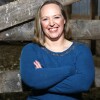The corn even made it in the ground by the late planting deadline at our farm, which I assume means it made it in everywhere. We don't often grow cash crops. All of the corn will be either chopped for silage or combined for grain corn for the cattle on the feedlot. Sorghum and sudangrass for feed haven't made it in the ground yet at the time I'm writing this, but those will follow soon.
ADVERTISEMENT
At least, the seeds will be in the ground soon, so long as the equipment cooperates.
Cattle are our focus here, as my husband runs a feedlot and has a small cow-calf herd. We also custom graze some cattle on pasture. We have pretty good quality cattle equipment, both for feeding and handling, and our haying equipment also tends to work pretty well. We use a precision feeding system that measures pounds of feed so we can not only bill our feedlot customers as accurately as possible but also so we can monitor intake. The expense of such things has been well worth it, because the cattle are the priority.
For some producers, crops are the priority, and planting season is a highlight of the year. It has all the optimism of a new season in sports. As that seed is going in the ground, its potential is boundless. Record yields. Fields with no weeds. The highest quality crop ever! Most of those farmers have invested in newer equipment and precision agriculture technologies that make the jobs in the field easier.
Suffice it to say, the investments in equipment we've made for the cattle side haven't been able to make it to the crop side. We don't have enough acres in crops to make new — or even newer — equipment make fiscal sense. Instead, my husband and father-in-law — and for that matter, my dad on his farm in Montana — make due with equipment that more often than not can be referred to as decades rather than years old.
In our case, a new (to us — but very far from actually new) four-wheel-drive tractor purchased last year gave some hope for an easier time. It's in great shape and seemed to drive great. But a little breakdown turned into a long breakdown, and the tractor spent little time in the field in the 2022 season.
This year has proved to be only slightly better, as the tractor again had problems that were bigger than they seemed at first. It's a common thing when you run old equipment, and perhaps even more common when you buy that equipment from someone else. A helpful mechanic got the tractor back up and running, but an implement it was pulling now has problems.
For my husband — who doesn't like to sit in a tractor in the best of circumstances — the breakdowns feel personal, as if the tractors and other equipment are banding against him. Every breakdown prolongs the season a little more.
ADVERTISEMENT
And add to those struggles the fact that the cattle don't just stop existing because it's planting season. Some are heading to pasture, where the fences need to be checked and usually fixed, especially after a . Some cattle still need to be fed around the yard. Calves get sick and need to be treated. Bulls need to be tested for the breeding season. And we even have a couple calving stragglers we're waiting on.
Diversified farms are important in spreading out risk in one way or another. For us, growing feed means a little more profit cushion compared to purchasing feed, as well as a little more control over the feed supply. The more we grow means the less we have to source from other places. For other farmers or ranchers, it means putting eggs in more than one basket to manage risk.
The problem in diversification is that it's hard to do a lot of things well and perhaps even harder to do the parts that aren't as enjoyable — which is different for every person.
The planting around here will get done, even if it takes longer than it should and provides more headaches. And we can dream about the possibility of having equipment that works on all parts of the farm.
Jenny Schlecht is Agweek's editor. She lives on a farm and ranch in Medina, North Dakota, with her husband and two daughters. She can be reached at jschlecht@agweek.com or 701-595-0425.













